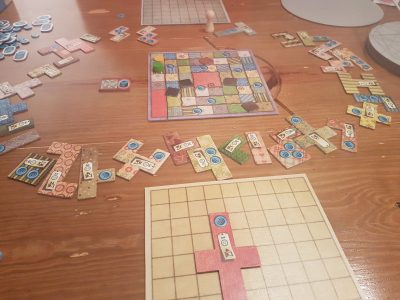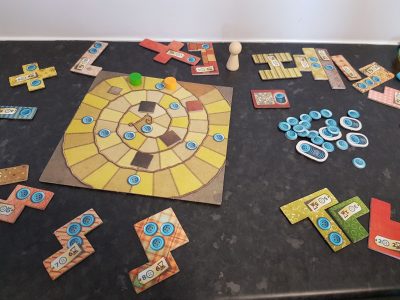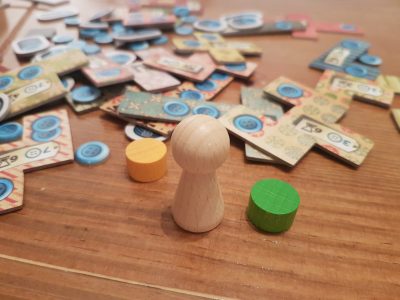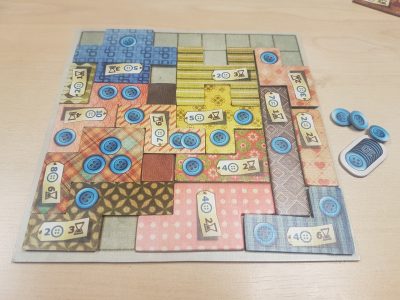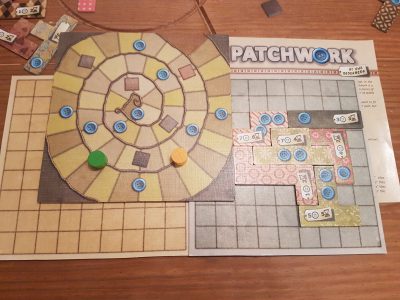Patchwork is an abstract puzzle based tile placement board game for two players from famed designer Uwe Rosenberg, which sees a quilt be sown and points scored. Using time wisely, players will look to fill in a 9×9 grid using scraps of fabric, overtime creating a patchwork style quilt. Rosenberg is known for games on both ends of the weight (difficulty) spectrum, with Patchwork falling on the lighter side. This being said, there is a layer of strategy that only truly surfaces after a handful of games.
Before the start of the game each player receives a 9×9 grid, either yellow or green in colour, and 5 buttons: the in-game currency, which double up as victory points. A player piece, or time token, of matching colour is placed at the start of the time board and tiles are placed in a circle around this time board. Each tile is an odd weird Tetris style shape that can fit together to create the quilt. Other than shape there are three attributes tiles have: a button cost, time spent and buttons on the fabric.
Unsurprisingly, the button cost is the number of buttons players must spend to purchase that tile. Cost varies heavily from 0 up to 10 buttons. While it is painful to spend 10 in one go, these pieces often cover a lot of empty space. The time spent dictates how far along around the time board the player moves their time token. Players only have a limited time, dictated by this tracker, to make their quilt. Finally, the buttons on the tiles indicate the income players will get at specific times while moving around the time board.
There are two special time board rules, which are triggered by moving past the icons, in the form of button income and leather patches. The button income mechanic is reminiscent of passing Go in Monopoly. After moving past one of the button symbols on the time board the player counts the number of buttons on his/her quilt and earns that many from the bank. This is one way to earn additional buttons to purchase tiles. There are also 5 1×1 leather patches that are claimed by whomever passes the icons first. These are ideal for filling in gaps, if you can calculate where gaps will be but sometimes they seem to backfire.
The design of Patchwork, mechanically, is nothing short of perfect. It is impossible to not have a move available, even if choice is not present. This wasn’t instantly obvious to me from reading the rules but something that keeps the game flowing. On a turn, players can either: [A] Jump ahead of the leader on the time board or [B] choose and place a tile. The trick is players don’t simply take it in turns. Instead, in a golf like system, the player furthest from the end of the time board is the player who gets a turn. This means when it is your turn jumping ahead is always an option: netting you buttons equal to the number of spaces moved.
Players don’t get to choose from the entirety of the tiles, there is a reason they are set in a large circle at the offset of the game. At the offset of the game a marker is placed next to the smallest (2×1 sized) tile. The next three tiles, clockwise from the marker, are then available. When a tile is chosen the marker moves to where it was taken from, moving around the tiles, opening up new tiles to be selected from. For teaching new players is can be worth making sure there isn’t a block of 3 or more tiles in a row costing 10 buttons. Finding solutions to the puzzle in front of them is enough for the first game without the frustration of expensive, or initially unaffordable, tiles.
During the game the first player to complete a 7×7 quilt gets a special non-placeable 7 bonus points tile. This doesn’t guarantee victory but does give an objective to aim for. Play continues until both players have reached the middle of the time board. Buttons are then counted (1 point each), the 7×7 quilt bonus is taken into account (7 points) and then 2 points are lost for every square left unfilled (2*x points). The player with the most points wins and they can then gloat about the amazingness of their quilt. I’m not afraid to admit I have ended a particularly bad game with minus points. Time caught up with me and a lot of holes remained at the end.
Buttons being a currency is as entertaining a thought as it is thematic. Throw into the mix that you are spending victory points to purchase new tiles and a whole level of strategy is revealed. Should you spend buttons to make buttons, spend high to use up less time on tiles or vice versa? Clearly, from my admission of minus points, I’m not the person to answer that: nonetheless, that is all part of the puzzle aspect of the game. Long term gain vs. short term benefit is a great puzzle that will change from game to game as tiles get chosen in different orders. So, there is always a puzzle aspect no matter how many times you have played.
Patchwork evolves alongside players. Initially, the game lacks interaction as players are solely focused on the puzzle in front of them. As experience increases and the solution becomes a little clearer, interaction is somewhat driven into the game as players choose to take sub-optimal tiles to stop their opponent obtaining specific tiles. This is the extent of the interaction and the limit of possible aggression. Though, it does have a knock-on effect on strategies employed by players when this stage is reached. The next layer of strategy to surface is the war of buttons. Players soon realise that jumping to gain buttons must be at the right time to avoid wasting precious time. Time becoming as much of a commodity as victory point awarding buttons.
While I wouldn’t say you cannot play with others of different experience, the gap is very much on show for Patchwork. Similar to other puzzle games if one player has played the game before they can spot the possible solutions available to them that bit quicker. It is almost like counting cards with new players as you know what shapes viably work together, and how best to accommodate them, while they are left learning it. A game of openness, without scoring, can help bridge this experience gap. Otherwise, it can leave the “noob” disheartened, without a full chance of getting in a victory.
Patchwork is less forgiving to those willing to leave gaps or holes than other puzzle tile placement games. Set your heart on a specific piece be prepared for it to be passed over, becoming unavailable, or maliciously taken by your opponent. If this occurs too often in a game chances are you’ll heavily lose. Patchwork isn’t but is closer to cutthroat than others games of a similar ilk as there are no 1×1 tiles and only one 2×1 tile, which is often snapped up early on. No longer can players rely on small shapes to fill in gaps. This draws out the ruthlessness in people with good pieces being snapped up, fully in the knowledge of how much it will ruin your beautiful quilt.
The short length of the game enables Patchwork to be an easy go to game. It also makes it hard to get the game off the table, with the loser often demanding a rematch. Whether gamers are looking for a quick 1 vs 1 filler, looking to pass sometime of an evening with a friend/partner or squeezing a game in at lunch; Patchwork is perfect for each situation. If you blitz through a game with limited analysis it’ll last just over a quarter of an hour. Taking a bit more time over things, which makes the game a little more pleasant when learning and allows for an increased amount of strategic thinking, Patchwork can hit the half hour mark. Anything over this and analysis paralysis has got in the way and perhaps puzzle games aren’t for you and/or your opponent.
Patchwork is an ideal gateway game to play as a couple. At the start it isn’t aggressive or take that, so no arguments should ever break out. When the strategies start to emerge both players are on the same experience level. It is also relatively quick to play so if you win or lose it doesn’t matter, the time invested won’t feel wasted for the loser, something which can occur in other 2-player only games. It is easy to pick up and play, with teaching the game taking only a matter of minutes. This stops any alienation a new board gamer might feel, perfect for sucking in a partner into the hobby! It manages to do all this while rocking undaunting, comfortable, if slightly unexciting aesthetics.
Surprisingly the game, despite not needing much room on a shelf, does need a decent amount of room on a table. This is due to the way the tiles are setup in a huge circle around the board. Due to the marker movement offering a choice of the next three tiles I cannot really see a quick solution to this other than a weird zigzag. Potentially a variety with only X number of tiles available at a time could have reduced this but this would lose some of the strategy that sucks players back in to play more Patchwork.
One aspect which triggered confusion for non-gamers, and is skimmed over in the rules, is the fact bonus points are awarded for a completed 7×7 quilt while players have a 9×9 board. As players lose points at the end of the game for empty spaces some initially assumed if they were rushing to complete a 7×7 quilt and only squares within their 7×7 quilt would count. Thankfully, I was able to point this out prior to play otherwise they could have easily been disheartened at losing via confusion.
The time board is double sided, yet it has missed a trick. Rather than making it different mechanically or order-wise, presenting a different experience, it instead is just visually different. While I appreciate being able to choose which I find more visually appealing, and clearer, it could have shaken up the gameplay. If one side featured more buttons near the start or a double single leather patch icon, where it doesn’t matter if you are first or second, there would be variation that could keep the game at the table longer.
Patchwork boils down to some very simple rules, with strategies that later emerge. Teaching takes minutes allowing players to pick up the game and play straight away, finding the solution to the puzzle rather than lost within the rules. As one of my all-time favourite video games is Tetris DX, all the way back on the Gameboy Colour, Patchwork’s pieces almost give a nostalgic nod. With shapes like the iconic video game, players do seem at home that bit quicker.
The theme is a mixed bag, it won’t offend anyone, it is homely yet won’t be inspiring much love for the game. Despite this, it is ideal thematically for making the mechanics make sense. After a few plays if a gamer isn’t heavily interested in puzzles Patchwork may lose a gamer’s interest. For those willing to delve deeper there comes a point where new strategies emerge, taking the game to a new level. This is what earns Patchwork it’s place on my shelf. Whether other puzzle tile placement games of a similar ilk can knock it off is yet to be seen.
[Editor’s Note: Patchwork was provided to us by Esdevium Games for review purposes. The game is currently available on 365 Games for £19.99. It is also available from local UK board game stores, find your local store here]

